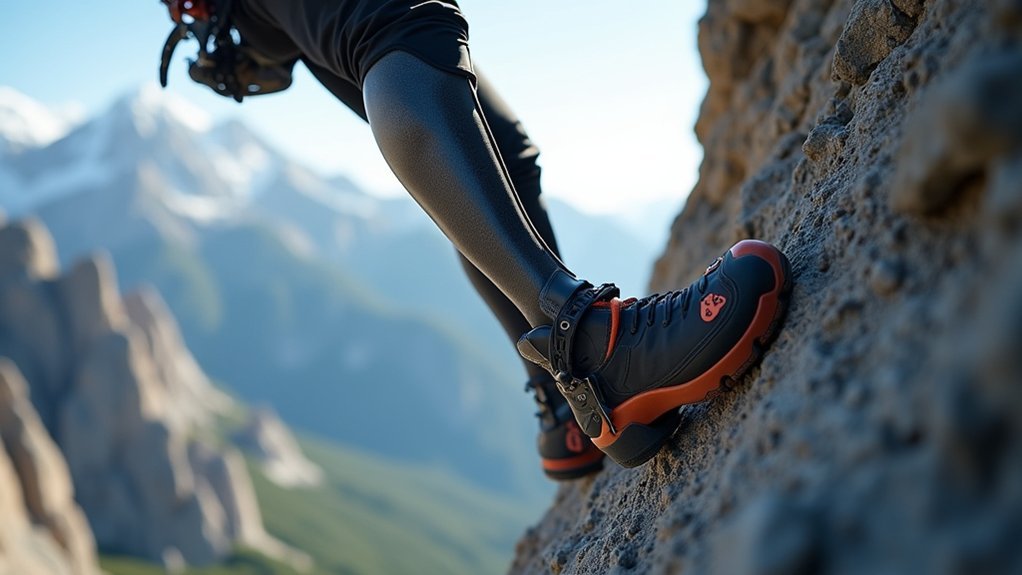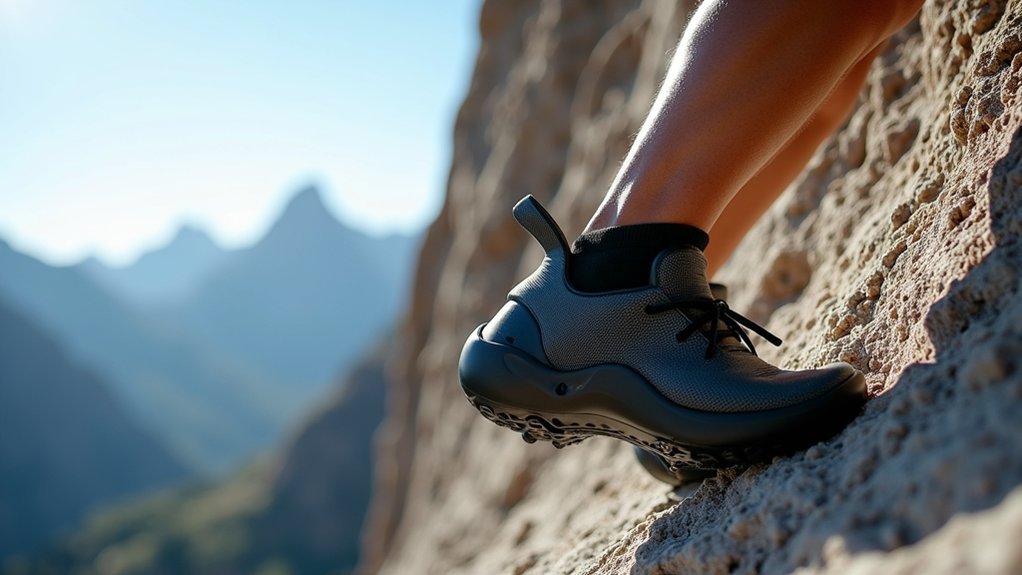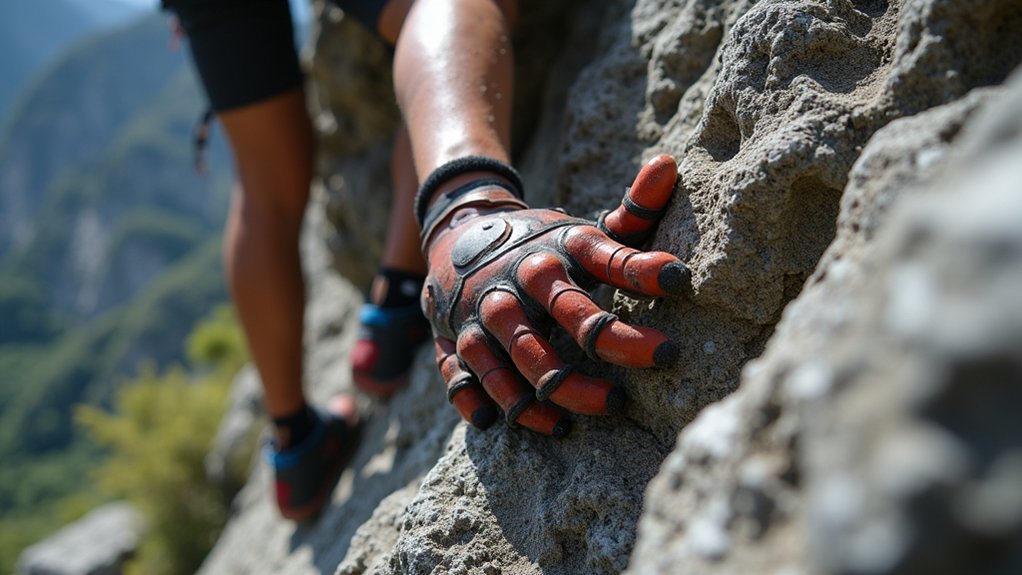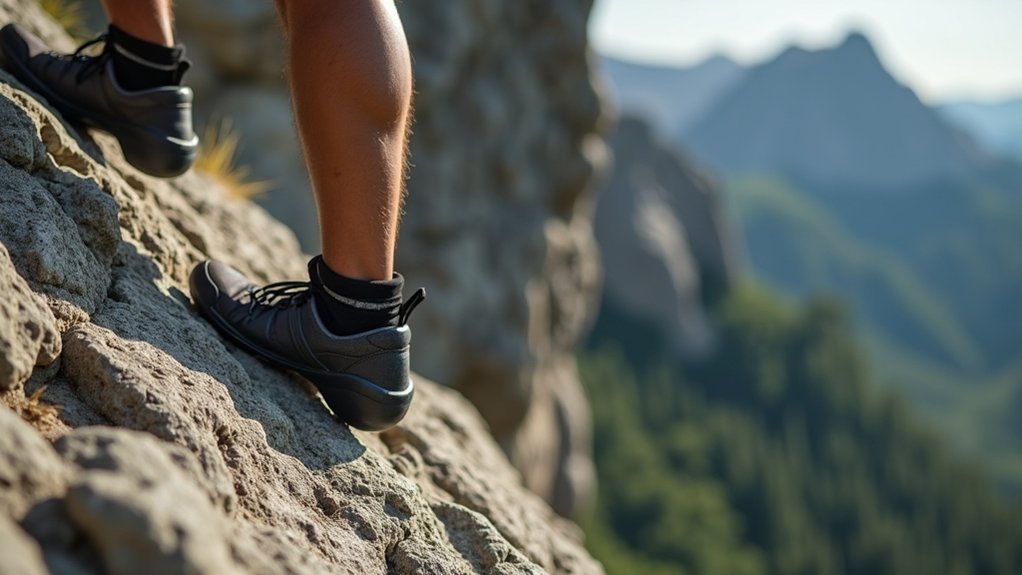Modern climbing prosthetics dramatically enhance performance through specialized lightweight materials that don’t fatigue like natural limbs. You’ll benefit from consistent balance on small footholds and customizable grip surfaces that adapt to various terrains. Their energy-storing capabilities mimic and sometimes exceed natural limb function, while their perfect weight distribution improves your balance on vertical terrain. With proper training techniques, these technological innovations can help you push beyond limitations you never thought possible.
Specialized Materials: The Foundation of Superior Climbing Prosthetics

While traditional prosthetics might suffice for everyday activities, rock climbing demands exceptional performance from specialized materials.
You’ll find that climbing-specific prosthetics utilize lightweight carbon fiber and titanium components that deliver maximum strength without adding unnecessary weight—a critical factor when you’re negotiating challenging rock faces.
These advanced designs incorporate energy-storing capabilities that mimic natural limb function, capturing and releasing energy with each movement.
This technology greatly improves your ability to push off surfaces and maintain momentum during climbs. The specialized materials also support biomimicry-inspired sole designs that enhance traction across varied climbing conditions.
Adaptive climbing tech transforms energy input into precise movements, creating natural responsiveness on even the most technical routes.
The result? You’ll experience superior balance, improved agility, and reduced fatigue—allowing you to tackle routes that might otherwise seem impossible with standard prosthetic options.
Biomechanical Advantages of Prosthetic Limbs in Vertical Terrain
Prosthetic limbs specifically engineered for climbing don’t just match natural limb function—they can actually offer distinct advantages on vertical terrain.
You’ll experience unprecedented stability with specialized climbing feet that provide consistent balance on even the smallest footholds—something lower-limb amputees often discover enhances their technique.
The biomechanical advantages become evident as you ascend challenging routes.
Advanced materials like carbon fiber deliver superior strength-to-weight ratios, allowing you to climb longer with less fatigue. Your prosthetic won’t tire or cramp, maintaining consistent performance throughout difficult climbs.
The progress prosthetic technology has made allows for energy-efficient designs that store and release power with each movement.
This mechanical efficiency, combined with customizable grip features that adapt to various rock surfaces, means you’ll often outperform expectations on vertical challenges that once seemed insurmountable.
Weight Distribution and Center of Gravity Benefits

Three significant advantages emerge when examining weight distribution in climbing prosthetics. You’ll achieve better balance on vertical terrain through prosthetics designed with a low center of gravity. This engineering approach dramatically improves your stability when maneuvering through challenging routes.
Your custom socket fit guarantees ideal weight distribution across your residual limb, reducing fatigue and enhancing climbing efficiency. Advanced materials like carbon fiber decrease overall weight while maintaining structural integrity.
| Benefit | With Standard Prosthetics | With Climbing Prosthetics |
|---|---|---|
| Balance | Higher center of gravity | Lowered center of gravity |
| Control | Limited grip precision | Enhanced foothold accuracy |
| Energy | Faster fatigue | Improved conservation |
| Safety | Higher fall risk | Reduced risk through better weight management |
These advantages translate directly to improved performance, allowing you to tackle more technical climbs with greater confidence.
Customizable Grip Attachments for Various Climbing Styles
When tackling diverse climbing challenges, you’ll need specialized grip options that adapt to each unique situation. Customizable grip attachments allow you to adjust your prosthetic hand for crimping, open-hand, or pinching techniques, markedly enhancing your performance on different holds.
You’ll benefit from adaptive grips designed for specific surfaces, providing better stability and control during difficult ascents. The advanced materials in these attachments, particularly silicone-based rubber, deliver superior traction while remaining lightweight—crucial for maintaining balance on technical routes.
Need to switch techniques mid-climb? Interchangeable options let you quickly adapt to each section’s demands.
Research shows these specialized attachments improve dexterity and reduce fatigue, so you’ll climb longer and more effectively, whether you’re training or competing.
Durability Under Extreme Conditions and Repetitive Stress

While adaptive grip technology enhances climbing functionality, the harsh environmental demands of rock faces require exceptional structural integrity from your equipment.
Your prosthetic design incorporates lightweight carbon fiber and titanium that won’t compromise performance during extended climbs.
You’ll benefit from integrated shock absorption systems that protect your residual limb from repetitive impact stress, allowing you to tackle challenging routes with confidence.
The advanced materials maintain structural integrity while providing the necessary flexibility for dynamic movements across various terrains.
Your prosthetic’s durability isn’t just about withstanding punishment—it’s engineered specifically for climbing’s unique stresses.
With interchangeable attachments and customized socket designs, you can adapt to different climbing challenges while minimizing wear.
Modern prosthetics undergo rigorous testing to guarantee they’ll perform reliably in the most extreme conditions you’ll encounter.
Energy Return Systems That Power Upward Movement
Energy return systems in today’s climbing prosthetics give you a critical edge through elastic energy storage mechanisms that compress and release power with each movement.
You’ll notice the difference when rebound propulsion technology transforms your downward force into upward momentum, propelling you higher with less effort.
These advancements work through joint-specific power transfer, directing stored energy precisely where you need it for efficient climbing sequences.
Elastic Energy Storage Mechanisms
As climbers ascend challenging routes, the efficiency of their movements becomes essential for success, making elastic energy storage mechanisms a revolutionary advancement in climbing prosthetics.
These systems capture energy during weight shifts and release it precisely when you need upward propulsion, dramatically reducing your physical exertion.
The specialized climbing feet equipped with energy return features allow you to shift smoothly between holds while the prosthetic provides critical propulsion at key moments.
You’ll notice improved stability and control on challenging terrain, as these systems work with your body’s natural movements.
Research confirms that climbing prosthetics with effective elastic energy storage mechanisms improve overall climbing performance so markedly that many amputee athletes now compete equally with able-bodied climbers, conserving energy for longer, more technical ascents.
Rebound Propulsion Technology
Three critical innovations define rebound propulsion technology in climbing prosthetics, transforming how amputee climbers navigate vertical terrain.
First, advanced materials like carbon fiber store energy during compression, then release it explosively during push-off, dramatically reducing your exertion on difficult routes.
Second, specialized energy return systems create a spring-like effect that powers your upward movement, giving you enhanced vertical propulsion when you need it most. You’ll find this advantage particularly valuable on overhangs and technical sections.
Finally, prosthetics with energy return improve your stability and control during dynamic movements across varied rock surfaces.
These design innovations work together to enhance your climbing performance while simultaneously reducing energy expenditure compared to traditional prosthetics—allowing you to climb longer, harder routes with less fatigue.
Joint-Specific Power Transfer
Joint-specific power transfer revolutionizes how energy flows through climbing prosthetics, enabling unprecedented vertical movement on challenging routes. When you’re scaling a wall, these specialized designs capture and redirect force with remarkable efficiency.
Your climbing prosthetics with advanced energy return systems don’t just support your weight—they actively contribute to your ascent. By optimizing power transfer from your body to the rock face, joint-specific designs guarantee that every ounce of effort translates into upward progress.
You’ll notice considerably enhanced grip and stability as the prosthetic responds to your movements.
The result? You’ll experience less fatigue during extended climbs as these systems distribute workload more evenly across your body. This targeted approach to energy management means you can tackle more difficult routes with greater confidence and endurance.
Adapting to Different Rock Surfaces and Textures
Rock surfaces present unique challenges that climbers with prosthetics must overcome through specialized equipment. Your prosthetic components now feature biomimicry-inspired foot soles that markedly enhance traction across varied terrains.
These designs don’t just facilitate adaptive sports participation—they revolutionize your climbing experience. You’ll notice how interchangeable attachments let you customize your setup for specific rock textures, improving grip whether you’re on limestone or granite.
Customization isn’t just an option—it’s your competitive advantage on any climbing surface you encounter.
The lightweight carbon fiber construction helps store and release energy efficiently, mimicking your body’s natural spring mechanism. This provides considerable physical benefits as you navigate complex routes.
When you climb with sensor-equipped prosthetics, you’ll experience responsive grip adjustments based on terrain conditions. This technology guarantees you maintain prime balance and agility regardless of surface complexity.
The Evolution of Climbing-Specific Prosthetic Design
The climbing prosthetics you’ll see on today’s rock faces have evolved dramatically from aluminum frames to carbon fiber marvels that offer unparalleled strength-to-weight ratios.
You’ll notice how these modern designs now incorporate biomechanical principles that mirror natural limb movements, with articulating joints that respond intuitively to your shifting weight and body position.
The most cutting-edge models feature specialized grip interfaces with customizable friction surfaces and interchangeable tips that you can quickly swap to match specific rock textures and climbing challenges.
Materials Revolution Drives Innovation
Revolutionary advancements in material science have fundamentally transformed climbing-specific prosthetic design over the past decade. You’ll find today’s lightweight prosthetics offer unprecedented performance advantages using carbon fiber and titanium, allowing you to navigate varied terrains with confidence.
| Material | Performance Benefit |
|---|---|
| Carbon Fiber | Superior strength-to-weight ratio |
| Titanium | Exceptional durability with reduced weight |
| Composite Polymers | Enhanced energy return during climbs |
| Silicone Interfaces | Improved socket comfort for extended use |
| Biomimetic Coatings | Better grip on rock surfaces |
Advanced prosthetics now incorporate energy-efficient technology that conserves your stamina during challenging ascents. The integration of bio-mimetic designs closely replicates natural limb movements, enabling you to achieve performance levels comparable to climbers with biological limbs. 3D scanning guarantees your prosthetic perfectly matches your residual limb’s unique topography.
Biomechanical Integration Advancements
While early climbing prosthetics focused mainly on basic functionality, today’s biomechanical integration represents a quantum leap in design philosophy. Your prosthetic limbs now work with your body rather than merely attaching to it.
Advanced biomechanical designs incorporate natural movement patterns that enhance grip and stability across diverse climbing surfaces.
You’ll notice the difference in how lightweight materials like carbon fiber mimic the spring and flexibility of biological limbs, dramatically improving energy transfer during challenging ascents. This evolution extends to specialized climbing feet that provide exceptional balance on tiny footholds.
Customization has become central to performance, with precisely fitted sockets ensuring comfort during extended climbs. The integration of adaptive sensors allows you to make real-time adjustments to grip strength based on terrain changes, giving you unprecedented control on the wall.
Specialized Grip Solutions
As climbing routes demand increasingly technical movements, specialized grip solutions have transformed prosthetic designs into highly effective climbing tools.
Your specialty prosthesis now features specialized grips with enhanced traction capabilities that perform across varied surfaces—from smooth granite to pocketed limestone.
Modern prosthetics incorporate lightweight carbon fiber materials, offering the perfect balance of strength and flexibility you need when maneuvering challenging routes.
The adaptive features in today’s climbing feet provide remarkable balance and precision on even the smallest footholds.
You’ll benefit from interchangeable attachments that allow customization based on specific route requirements and environmental conditions.
Some cutting-edge models even integrate smart technology that adjusts grip dynamics in real-time, helping you adapt instantly to changing surfaces as you climb higher.
Training Techniques to Maximize Prosthetic Climbing Performance
Because climbing with prosthetics requires specialized skills beyond traditional climbing techniques, targeted training approaches can dramatically improve your performance and confidence on the wall. Focus on building core strength, coordination, and endurance to maximize your prosthetic’s effectiveness.
| Training Technique | Benefits |
|---|---|
| Core Strengthening | Improves stability and balance during dynamic moves |
| Gamified Rehabilitation | Makes physical therapy engaging while building prosthetic confidence |
| Adaptive Climbing Groups | Provides mentorship and real-world practice with proper guidance |
| VR Simulation Training | Enhances muscle memory in a controlled environment |
Regular prosthetic fit adjustments during training sessions guarantee ideal comfort and performance. Start with structured practice in climbing gyms before tackling outdoor routes, allowing your body to adapt to the unique movements required with your specialized equipment.
Real-World Success Stories: Athletes Breaking Barriers With Prosthetics
Despite facing significant physical challenges, numerous adaptive athletes have revolutionized rock climbing through specialized prosthetics designed for vertical terrain. Maureen Beck, a transfemoral amputee, exemplifies this transformation, achieving remarkable competition success that inspires climbers worldwide.
You’ll find compelling evidence at the Paraclimbing World Championships, where athletes using advanced prosthetics regularly secure podium positions. Their achievements demonstrate how cutting-edge carbon fiber designs dramatically enhance performance by improving grip, balance, and agility on challenging routes.
Research confirms these prosthetic innovations reduce energy expenditure for rock climbers with limb differences, enabling longer climbs and improved endurance.
Beyond physical benefits, athletes report significant confidence boosts that encourage greater participation in competitions, continuously pushing boundaries of what’s possible in adaptive climbing.
Future Innovations in Adaptive Climbing Technology
While current prosthetic designs have already transformed adaptive climbing, the horizon promises even more revolutionary technologies that will redefine possibilities for climbers with limb differences.
You’ll soon see smart prosthetics equipped with AI and sensors that automatically adjust grip strength to match different terrain challenges, considerably enhancing your safety and performance.
The integration of lightweight materials like carbon fiber will dramatically improve your movement efficiency while reducing fatigue during difficult ascents.
Advanced 3D scanning technology will create perfectly customized prosthetic sockets that optimize stability on challenging routes.
Perhaps most exciting are the developing energy-storing systems that mimic natural limb mechanics, allowing you to conserve energy during lengthy climbs.
These innovations, created through collaborations between manufacturers and professional climbers, will continue breaking barriers in adaptive climbing performance.
Frequently Asked Questions
Why Might the Rock Climber’s Prosthetic Leg Work Even Better Than a Biological Limb?
Your prosthetic leg excels because it’s lighter than a biological limb, stores and releases energy efficiently, provides customized grip on difficult surfaces, and reduces fatigue during climbs, enhancing your overall performance.
Do People With Prosthetics Run Faster?
You’ll find that specialized running prosthetics can match or even exceed natural limb performance in certain conditions, thanks to energy-storing carbon fiber designs that reduce energy costs and optimize your speed, especially during sprinting.
How Does Rock Climbing Improve Physical Health?
Rock climbing improves your physical health by strengthening your upper body, core, and legs while boosting cardiovascular fitness. You’ll also enhance flexibility, balance, burn calories, and reduce stress during challenging climbs.
What Are the Advantages of Prosthetics in Sports?
Prosthetics give you a competitive edge through customization for your specific needs, reduced weight with high-tech materials, better energy efficiency, and enhanced grip. They’ll improve your performance metrics across various sports activities.
In Summary
Climbing prosthetics aren’t just adaptive equipment—they’re performance enhancers that transform your climbing experience. You’ll find yourself achieving what seemed impossible as you leverage their lightweight materials, specialized grips, and biomechanical advantages. Whether you’re scaling indoor walls or conquering outdoor routes, these purpose-built tools will continue evolving with technology. Don’t view them as limitations; embrace them as specialized gear that gives you unique advantages on the vertical path.





Leave a Reply